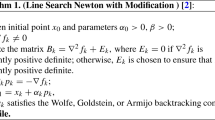Abstract
We consider solving an unconstrained optimization problem by Newton-PCG like methods in which the preconditioned conjugate gradient method is applied to solve the Newton equations. The main question to be investigated is how efficient Newton-PCG like methods can be from theoretical point of view. An algorithmic model with several parameters is established. Furthermore, a lower bound of the efficiency measure of the algorithmic model is derived as a function of the parameters. By maximizing this lower bound function, the parameters are specified and therefore an implementable algorithm is obtained. The efficiency of the implementable algorithm is compared with Newton’s method by theoretical analysis and numerical experiments. The results show that this algorithm is competitive.
Similar content being viewed by others
References
R. Brent (1973) ArticleTitleSome efficient algorithms for solving systems of nonlinear equation SIAM Journal on Numerical Analysis 10 327–344
A.R. Conn N.I.M. Gould P.L. Toint (Eds) (1992) LANCELOT: A Fortran Package for Large-Scale Nonlinear Optimization (Release A), Springer Ser. Comput. Math. Vol. 17 Springer-Verlag, Heidelberg Berlin, New York.
A.R. Conn N. Gould P.L. Toint (Eds) (1992) Numerical Experiments with the LANCELOT package (Release A) for large-scale nonlinear optimization, Technical Report, 92–075 Rutherford Appleton Laboratory Chilton, England.
R. Dembo S. Eisenstat T. Steihaug (1982) ArticleTitleInexact Newton method SIAM Journal on Numerical Analysis 19 400–408 Occurrence Handle83b:65056 Occurrence Handle0478.65030
N.Y. Deng Z.Z. Wang (2000) ArticleTitleTheoretical efficiency of an inexact Newton method Journal of Optimization Theory and Applications 105 97–112
J.E. Dennis R.B. Schnabel (Eds) (1983) Numerical methods for Unconstrained Optimization and Nonlinear Equations Prentice-Hall, Inc., Englewood Cliffs New Jersey.
L.C.W. Dixon R.C. Price (1988) ArticleTitleNumerical Experience with the Truncated Newton method for unconstrained optimization Journal of Optimization Theory and Applications 56 245–255
S.C. Eisenstat H.F. Walker (1996) ArticleTitleChoosing the forcing terms in an inexact Newton method SIAM Journal on Scientific Computing 17 33–46
P.E. Gill W. Murray M.H Wright (Eds) (1981) Practical Optimization Academic Press London and New York.
G.H. Gould C.F. Vanloan (Eds) (1996) Matrix Computations, 3rd ed., The Johns Hopkins University Press Baltimore.
Luenberger, D.G. (1984), Linear and Nonlinear Programming, 2nd ed., Addison-Wesley Publishing Company.
J.J. More B.S. Garbow K.E. Hillstrom (1981) ArticleTitleTesting unconstrained optimization software ACM Transactions on Mathematical Software 7 17–41
Nocedal, J. (1996), Large scale unconstrained optimization, Report-DEECS, Northwestern University.
Nocedal, J. and Wright, S.J. (1999), Numerical Optimization, Springer.
J.M. Ortega W.C. Rheinboldt (1970) Iterative Solution of Nonlinear Equations in Several Variables Academic Press London
A. Ostrowski (Eds) (1960) Solution of Equations and Systems of Equations Academic Press New York
Saad, Y. (1996), Iterative Methods for Sparse Linear Systems, PWS Publishing Company.
T. Steihaug (1993) ArticleTitleThe conjugate gradient method and trust region in large scale optimization SIAM Journal on Numerical Analysis 20 626–637
P.L. Toint (1981) Towards an Efficient Sparsity Exploiting Newton Method for Minimization I.S. Duff (Eds) Sparse Matrices and Their Uses Academic Press London, England 57–88
Author information
Authors and Affiliations
Corresponding author
Additional information
Mathematics Subject Classification: 90C30, 65K05.
This work was supported by the National Science Foundation of China Grant No. 10371131, and Hong Kong Competitive Earmarked Research Grant CityU 1066/00P from Hong Kong University Grant Council
Rights and permissions
About this article
Cite this article
Deng, N., Xue, Y., Zhang, J. et al. An Inexact Newton Method Derived from Efficiency Analysis. J Glob Optim 31, 287–315 (2005). https://doi.org/10.1007/s10898-004-5701-0
Received:
Accepted:
Issue Date:
DOI: https://doi.org/10.1007/s10898-004-5701-0




